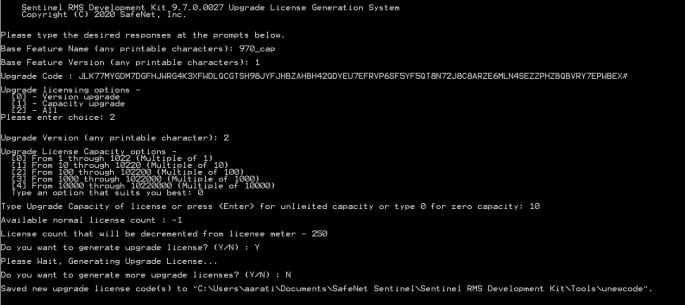Generating Upgrade License Code
You can generate the upgrade license code using:
>WlscGen (a Windows utility)
>Ulscgen (a command line utility for Windows, UNIX)
Create Upgrade License Template using WlscGen
WlscGen (a Windows utility) allows you to generate the upgrade license code to upgrade the version and capacity of your base license. Your base license is generated by using the full license template in WlscGen or by using lscgen.
NOTE Version upgrade is allowed for non-capacity, pooled, and non-pooled base licenses; but capacity upgrade is allowed only for non-pooled capacity licenses.
To create upgrade license templates using WlscGen:
1.Click New on the License Template screen. The License model dialog box is displayed.
2.Click the Upgrade license template option on the License model dialog box.
3.Click OK.
4.To create the new upgrade license template, access the License features, New template file dialog box.
NOTE For details on creating a new template or editing an existing one, refer to the Windows License Code Generator Help. Click Help Topics in the Help menu or press F1.
5.After you have created the upgrade license template, it is added to the License Template screen.
6.On the License Template screen, select an upgrade license template.
7.(Optionally), perform the following steps:
•To edit the existing template file, click Edit.
•To delete an existing template file, click Remove.
8.To generate the upgrade license code, click Generate.
Create Upgrade License Template Using Ulscgen
The upgrade license code can also be generated by the upgrade license code generator (a command line utility for Windows, UNIX).
NOTE Before generating the upgrade license code, you need to generate the upgrade locking code for the base license using echouid.
A sample of the command line upgrade code generator user interface is shown below:

Sentinel RMS Development Kit Upgrade License Generation System
Copyright (C) 2006 SafeNet, Inc.
Type the desired responses at the prompts below.
Base Feature Name: f1
Base Feature Version: v1
Upgrade Code : EKUMEM9ZJDF92U396CFLWE3D6BJGBYWT2SQ8WTCQA3JQ8ENV6ULFP9D5FAAKQ3C9HX964U6VWP2CQ7O#
Upgrade licensing options -
[0] - Version upgrade
[1] - Capacity upgrade
[2] - All
Enter choice: 2
Upgrade Version: v2
Upgrade License Capacity options -
[0] From 1 through 1022 (Multiple of 1)
[1] From 10 through 10220 (Multiple of 10)
[2] From 100 through 102200 (Multiple of 100)
[3] From 1000 through 1022000 (Multiple of 1000)
[4] From 10000 through 10220000 (Multiple of 10000)
Type an option that suits you best: 1
Type Upgrade Capacity of license or press <Enter> for unlimited capacity or type 0 for zero capacity: 2000
Available normal license count : 3096
License count that will be decremented from license meter - 250
Do you want to generate upgrade license? (Y/N) : y
Please Wait, Generating Upgrade License...
Message (VLS0041): Your Sentinel RMS Development Kit license meter(s) have been decremented by 250 units. You now have 2846 units left out of an initial count of 4096 units.
Do you want to generate more upgrade licenses? (Y/N) : n
Saved new upgrade license code(s) to "upgradelic1".
The following table briefly describes the upgrade license code generator command-line options.
| Option | Description |
|---|---|
| -h | Displays the help for upgrade license code generator. |
| -ver | Enables the user to generate an older version library upgrade code. |
| -upid | Specifies the upgrade locking code of base license. |
| -E | Specifies the Feature Name of the base license that needs to be upgraded. |
| -v | Specifies the Feature Version of the base license that needs to be upgraded |
| -u |
Bit wise flag. Controls what will be updated: >VLSucg_UPGRADE_VERSION >VLSucg_UPGRADE_CAPACITY >VLSucg_UPGRADE_ALL |
| -uv | Specifies the new version for this feature. |
| -cap_units | Determines capacity least count. |
| -cap | Specifies capacity increment for this feature. |
NOTE If the base license is a non-capacity license, then the upgrade license code generator does not ask for the capacity upgrade option. The version upgrade option is also set by default.
